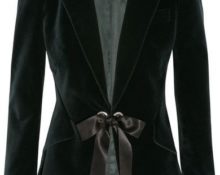 Every business person probably has such a piece of clothing as a jacket in their wardrobe. It is this detail of the costume that emphasizes his status and position in society. A well-groomed man in a formal jacket always attracts attention and commands trust, achieving success both in his career and in his personal life. But it is worth remembering that good fit and appearance of the product depend not only on the quality and type of material used. Correct and timely care is of great importance, in the process of which ironing is one of the main steps.
Every business person probably has such a piece of clothing as a jacket in their wardrobe. It is this detail of the costume that emphasizes his status and position in society. A well-groomed man in a formal jacket always attracts attention and commands trust, achieving success both in his career and in his personal life. But it is worth remembering that good fit and appearance of the product depend not only on the quality and type of material used. Correct and timely care is of great importance, in the process of which ironing is one of the main steps.
How to iron a jacket: choosing a method
There are several ways to tidy up your jacket and smooth out every detail of your clothing on your own:
- using a special steamer;
- using an iron.
 Steaming with a steam generator or an iron with this function is the most effective and fastest method and is suitable for all types of fabrics.The powerful steam jet of the steam generator does not damage the fabric surface of the product, while smoothing out bends in hard-to-reach places.
Steaming with a steam generator or an iron with this function is the most effective and fastest method and is suitable for all types of fabrics.The powerful steam jet of the steam generator does not damage the fabric surface of the product, while smoothing out bends in hard-to-reach places.
REFERENCE!
It is recommended to iron a jacket with embroidery or decorations only using steam!
 Electric steamers are not cheap, so not all people have the opportunity to use them. In this case, there is a cheaper, but no less effective way - steaming in the bathroom. To do this, fill the bathtub with boiling water and place a jacket on hangers over it for 30 minutes. The doors to the room must be closed tightly so that the steam completely envelops the product.
Electric steamers are not cheap, so not all people have the opportunity to use them. In this case, there is a cheaper, but no less effective way - steaming in the bathroom. To do this, fill the bathtub with boiling water and place a jacket on hangers over it for 30 minutes. The doors to the room must be closed tightly so that the steam completely envelops the product.
IMPORTANT!
After steam ironing in the bathroom, things get wet, so they need to be dried immediately after the procedure.
Is it possible to iron a jacket with an iron?
 Many fabrics from which clothing is made are not intended for ironing, since their structure cannot withstand high temperatures. Therefore, before starting the work process, you must carefully study the tag, which contains exact recommendations for setting the temperature mode in accordance with the material of the item. If the iron is crossed out, you must use a different smoothing method.
Many fabrics from which clothing is made are not intended for ironing, since their structure cannot withstand high temperatures. Therefore, before starting the work process, you must carefully study the tag, which contains exact recommendations for setting the temperature mode in accordance with the material of the item. If the iron is crossed out, you must use a different smoothing method.
How to iron a jacket at home
You can iron any jacket well and quickly when the work process is smooth and comfortable. This will help iron even a child’s jacket that is heavily wrinkled. Therefore, before you start ironing, you need to properly prepare:
- install an ironing board with a narrow attachment for sleeves and other small parts;
- arm yourself with an iron (preferably with a steam function);
- have a small piece of cotton fabric or gauze on hand;
- Prepare a container with clean water.
One of the basic rules for ironing a jacket is the absence of stains or dirt on its surface.. Before you start work, you need to carefully inspect the clothes, since not only the appearance of the ironed product, but also its further suitability depends on this.
ATTENTION!
When exposed to hot temperatures, shiny areas or old stains penetrate deep into the fibers of the fabric, settling firmly in them. Subsequently, it is almost impossible to remove them. Therefore, before ironing, it is recommended to dry clean even clean items that have been stored in the closet for a long time.
 When the clothes are completely prepared for work, you need to lay them out on a board and straighten out all the parts to get rid of old folds, which can later ruin the appearance.
When the clothes are completely prepared for work, you need to lay them out on a board and straighten out all the parts to get rid of old folds, which can later ruin the appearance.
How to properly iron a jacket: sequence of actions
It is very difficult to iron a jacket correctly so that it fits perfectly and has an impeccable appearance on your own. For this purpose, a whole system has been developed, the implementation of which determines the final result and success.
It is recommended to iron the jacket in a certain sequence:
What is ironed first?
 Pockets are ironed first.. Before starting the work process, turn the product inside out and clear the contents, including the smallest particles of remaining debris. Then we straighten the pocket pouch well on both sides to get rid of creases and folds (you can use moistened gauze to make it easier). Iron the pocket on both sides and turn it inside out.
Pockets are ironed first.. Before starting the work process, turn the product inside out and clear the contents, including the smallest particles of remaining debris. Then we straighten the pocket pouch well on both sides to get rid of creases and folds (you can use moistened gauze to make it easier). Iron the pocket on both sides and turn it inside out.
IMPORTANT!
After using wet gauze, the fabric becomes wet and becomes a favorable place for mold to grow.To avoid this, iron the wet part of the pocket through a dry piece of cotton.
How to iron jacket sleeves
 These parts of the jacket are also ironed from the reverse side, but require more attention and effort. The turned-out piece of clothing is placed on a narrow armrest attached to the ironing board. The sleeve begins to be steamed at maximum temperature, gradually scrolling along the axis and moving to the shoulder area.
These parts of the jacket are also ironed from the reverse side, but require more attention and effort. The turned-out piece of clothing is placed on a narrow armrest attached to the ironing board. The sleeve begins to be steamed at maximum temperature, gradually scrolling along the axis and moving to the shoulder area.
REFERENCE!
The armband can be replaced with a towel tightly rolled into a roll.
How to smooth collars, lapels, fronts and edges
These areas can be ironed from both the front and back sides. But in the first case, it is necessary to use a moistened lining or gauze so that the iron does not leave marks on the surface of the product. It is not recommended to iron buttons or metal stripes, as they will lose color and leave marks on the clothing.
 Lapels and collar are important details of a jacket, which, when wrinkled, spoil the appearance of the garment. These parts must be ironed from the front side, after placing gauze moistened with water on the fabric. Hard-to-reach corners should be passed with the tip of the iron using steam.
Lapels and collar are important details of a jacket, which, when wrinkled, spoil the appearance of the garment. These parts must be ironed from the front side, after placing gauze moistened with water on the fabric. Hard-to-reach corners should be passed with the tip of the iron using steam.
How to properly iron a jacket depending on the type of fabric
To put a jacket in order after washing or lying in the closet for a long time, having ironed every detail well, you must adhere not only to the order of actions, but also follow certain rules indicated on the label of each item. The temperature regime and the ironing process itself, in accordance with the material of the product, may change.
- Wool or wool mixture.
 The temperature of a heated iron for such fabrics should not exceed 165°. It is recommended to iron wool (half-wool) using moistened gauze folded in several layers. If the item is slightly not completely dry after washing, then there is no need to wet the gauze pad.
The temperature of a heated iron for such fabrics should not exceed 165°. It is recommended to iron wool (half-wool) using moistened gauze folded in several layers. If the item is slightly not completely dry after washing, then there is no need to wet the gauze pad.
REFERENCE!
Clothes made of wool can stretch or shrink, so do not press the seams and edges of the product too much.
- Velveteen.
 This type of material requires special attention and patience. It is much easier to iron the fabric surface when wet. It is better to do this with a warm iron and not from the outside. The board, which should have a soft surface (often using a blanket), is also of great importance. Iron the jacket from the wrong side, in the direction of the nap.
This type of material requires special attention and patience. It is much easier to iron the fabric surface when wet. It is better to do this with a warm iron and not from the outside. The board, which should have a soft surface (often using a blanket), is also of great importance. Iron the jacket from the wrong side, in the direction of the nap.
ATTENTION!
The easiest and most effective way to iron corduroy is to use steam. Just fill the iron with water and turn on the steam mode. After this procedure, the corduroy jacket becomes like new.
- Linen and cotton.
 This jacket should be ironed damp or with dampened gauze. If there is no lining, the product can be ironed at 230 °C on the reverse side through moistened gauze. If there is a lining, it is necessary that the temperature matches its material, otherwise it may be damaged and the jacket will lose its beautiful appearance.
This jacket should be ironed damp or with dampened gauze. If there is no lining, the product can be ironed at 230 °C on the reverse side through moistened gauze. If there is a lining, it is necessary that the temperature matches its material, otherwise it may be damaged and the jacket will lose its beautiful appearance.
- Natural silk.
 Often, silk items are not ironed; this is done only when absolutely necessary. Then you need to select the “silk” or 150° mode on the iron and go through the undyed, dampened napkin or loose fabric with the iron from the inside out. You can also steam the product with warm steam.
Often, silk items are not ironed; this is done only when absolutely necessary. Then you need to select the “silk” or 150° mode on the iron and go through the undyed, dampened napkin or loose fabric with the iron from the inside out. You can also steam the product with warm steam.
- Polyester.
Synthetic items are ironed very rarely. This is done only with an iron, since steaming is not suitable.To select the correct mode, you must read the notes on the product label.
How to iron a jacket at home: a few tricks
In order for clothes to always look like new, and for its owner to have a neat appearance, you need to know some subtleties in the ironing process:
- It is not recommended to put the jacket in the closet or put it on immediately after ironing. It is necessary to leave the item on the board until it cools completely. Then the product will take its shape.
- The light when ironing for right-handers should fall from the left side, for left-handers, respectively, from the right. With the correct stance, all present flaws are clearly visible.
- A product with buttons requires some care, since the sole of the iron can be damaged by the surface of the accessories present.
- For fabrics with a fleecy surface, only reverse ironing is used., moving the nose of the iron from the top to the bottom (in one direction), then the finished product will not have kinks on the outside.
- When wetting the gauze, it is necessary to wring it out well so that shiny areas do not appear on the product.
- Items with drawings and patterns are advised to be ironed only from the inside out. When smoothing pockets or other small items externally, use a compacted napkin.
- You can get rid of shiny areas on fabric using woolen fabric. It must be placed on an area of clothing and ironed.
These simple recommendations will help you iron your jacket correctly and keep it looking great for a long time. For better clarity, you can also watch several videos, however, the main recommendations are presented here.
How to iron a jacket without burning it
 A jacket tag is a real helper for every housewife.It indicates temperature conditions that can be used for a certain type of material. Before starting work, you must read the instructions for use of the unit itself. There are established platform heating standards for each type of fabric.
A jacket tag is a real helper for every housewife.It indicates temperature conditions that can be used for a certain type of material. Before starting work, you must read the instructions for use of the unit itself. There are established platform heating standards for each type of fabric.
Woolen items require a special approach. During the ironing process, you should not leave the iron on the clothes for a long time, as yellow spots may appear, and subsequently burn holes. Items that are not designed for ironing should be ironed using a steamer. By following all precautions during ironing, you can always bring a jacket made of any fabric into excellent shape without burning it.


 0
0





